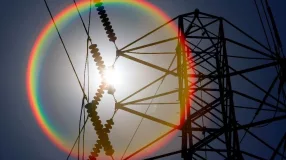Reducing greenhouse gas emissions and promoting the deployment of renewable energy technologies have been recurring themes in the conversations this year surrounding Earth Day. In the United States, natural gas has proven to be a powerful ally in achieving these goals, enabling the United States to lead the globe in greenhouse gas emissions reductions while also supporting the increased use of renewables in the U.S. energy mix.
Source: U.S. Energy Information Administration
It is no coincidence that the increased natural gas consumption in the United States coincides with significant greenhouse gas emissions reductions and tremendous growth in renewables. Because natural gas is clean-burning and domestically abundant, it has numerous economic and environmental benefits, reducing emissions and serving as the ideal foundation for increased use of renewables. Able to ramp up quickly and firm up intermittent renewable resources such as wind and solar, natural gas serves as a “backstop” for renewable generation and helps stabilize the overall costs of electric power.
Taylor Farms demonstrated natural gas’ environmental benefits when they announced on Earth Day that a combination of solar, wind, fuel cells and a natural gas-fired cogeneration plant enabled them to reduce their carbon dioxide emissions by 12,190 metric tons – a 94-percent increase from 2017:
“When combined with power from solar and wind, the facility’s annual energy usage is offset by over 90 percent. The GHG emissions saved directly from the cogeneration plant is equivalent to taking 734 cars off the road or 414 homes’ annual energy use.”
Indeed, Taylor Farms’ impressive CO2 reductions are in line with the recommendation of experts and scientific organizations around the world, stressing that natural gas is critical to promoting the use of renewables and reducing our collective environmental footprint.
As the International Energy Agency notes:
“Natural gas has an important role to play in complementing low-carbon energy solutions by providing the flexibility needed to support a growing renewables component in power generation.”
This point was echoed a few weeks ago by former Secretary of Energy Ernest Moniz in a presentation of his report, "Optionality, Flexibility & Innovation: Pathways for a Deep Decarbonization in California," at Stanford University. According to Secretary Moniz:
“Natural gas generation will continue to play a key role in providing California’s electric grid with operational flexibility and enabling the growth and integration of intermittent renewables. Natural gas-fired generation provides key load-following services. It has short- and long-duration applications, including the management of seasonal shifts in demand.”
Importantly, choosing between natural gas and renewables is not an “either/or” proposition, as recently noted by the Independent System Operator New England, commonly referred to as ISO New England, in its 2019 Regional Electricity Outlook:
“Until electric storage or other technologies have the ability to supply quick energy for longer periods and in greater quantities, flexible natural-gas resources are a necessary element of the hybrid grid, not only to help supply the ‘missing energy’ when the weather is uncooperative for wind and solar resources, but also to provide the precise grid-stability and reliability services that renewables generally cannot.”
Natural gas has enabled the United States to lead the world in emissions reductions while simultaneously growing the economy and supporting development of renewable energy technologies. So as we celebrate Earth Day this year, the United States’ experience demonstrates the importance of natural gas to a low-carbon energy future, especially as the global economy continues to grow.
For more information on how natural gas and renewables work together, please click here.







